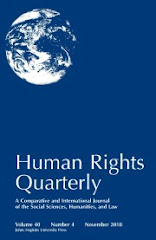Two interrelated trajectories are exerting pressure on a fundamental premise that has long undergirded international human rights law (IHRL). That premise — that the state is the primary entity that bears international-legal responsibility for respecting, protecting, and fulfilling human rights — stems in part from the (largely exclusive) competence of states to make, adjudicate, and enforce rules within their respective jurisdictions. The first trajectory is that, in a number of key respects, certain entities and scholars are increasingly recognizing the possibility of non-state entities bearing de-jure or de-facto human-rights obligations or related responsibilities. And the second trajectory is that, seemingly increasingly, ANSAs control access to territory and exercise control over civilian populations.
Several significant legal, policy, and practical concerns are at issue in whether armed non-state actors (ANSAs) will ultimately be recognized — by all relevant institutions and actors — as bearing human-rights obligations in general under international law in a manner previously reserved primarily for states. In considering this set of issues, it is important to clarify what obligations, if any, the United Nations (U.N.) Security Council and the U.N. General Assembly recognize ANSAs as possessing under IHRL. This June 2017 Briefing Report with Annexes provides an overview of research conducted by HLS PILAC concerning modalities in which the U.N. Security Council and the U.N. General Assembly have addressed ANSAs with respect to human rights; ways in which these U.N. principal organs have distinguished between different types of ANSAs; and the consequences of these organs possibly establishing responsibility of ANSAs in relation to the protection and fulfillment — or, at least, the non-abuse — of human rights.
While it is incontrovertible that the U.N. Security Council and the U.N. General Assembly have recognized, at a minimum, that the conduct of at least some ANSAs can amount to violations or abuses of human rights, it is not currently possible to state that either of these principal U.N. organs has taken sufficient steps to formally endow ANSAs with human-rights obligations in general under international law.
Tuesday, July 11, 2017
Burniske, Modirzadeh, & Lewis: Armed Non-State Actors and International Human Rights Law: An Analysis of the Practice of the U.N. Security Council and the U.N. General Assembly
Jessica Burniske (Harvard Univ. - Program on International Law and Armed Conflict), Naz K. Modirzadeh (Harvard Univ. - Program on International Law and Armed Conflict), & Dustin A. Lewis (Harvard Univ. - Program on International Law and Armed Conflict) have posted Armed Non-State Actors and International Human Rights Law: An Analysis of the Practice of the U.N. Security Council and the U.N. General Assembly. Here's the abstract:





